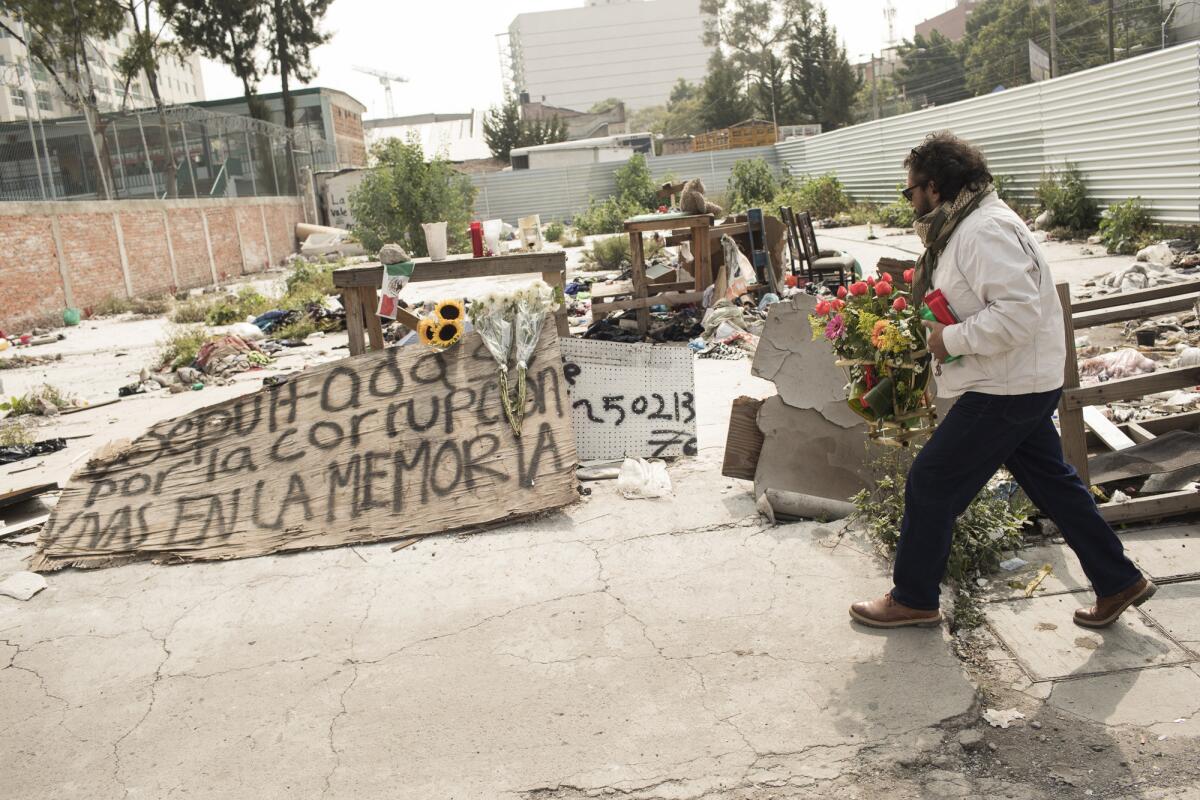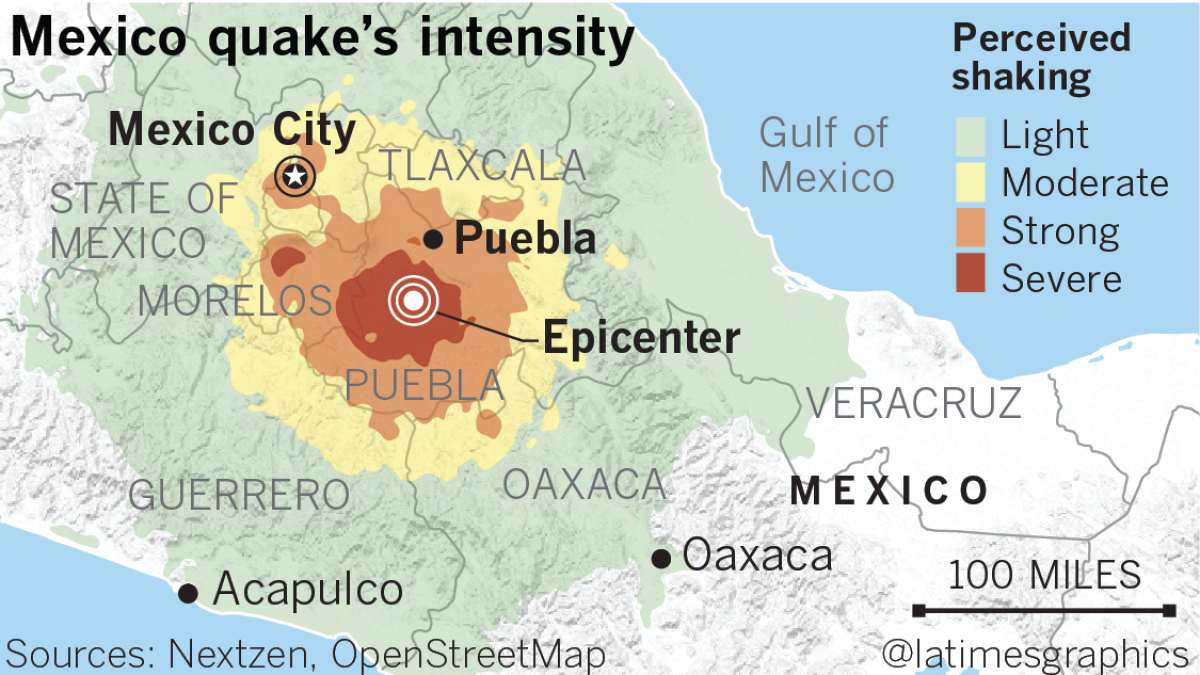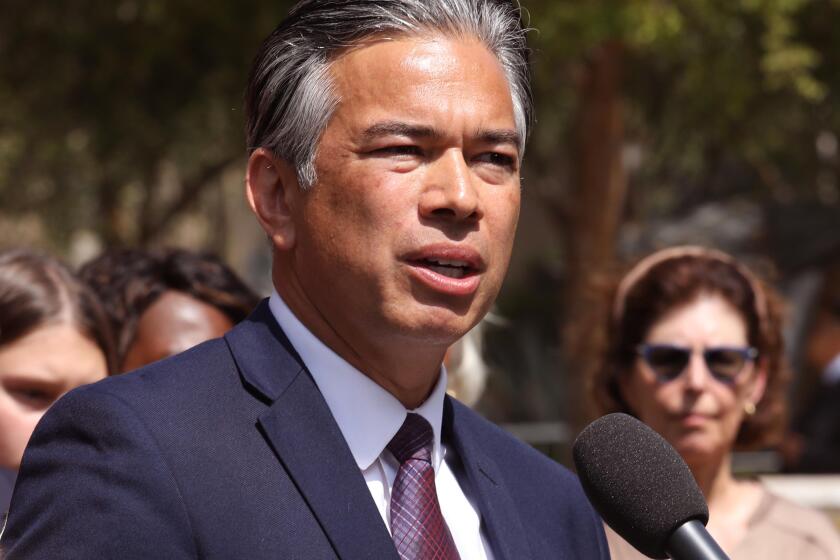The Mexico City quake last year took his mother and sister. Now he wants their permission to move on

- Share via
Maria Teresa Lira and her daughter were at work inspecting merchandise at a factory in downtown Mexico City when the ground started convulsing.
They stumbled toward the stairs, but before they could make it outside, the five-story building tilted and then collapsed onto them with a deafening roar.
At home four miles away, Lira’s son, Fernando Sanchez Lira, 51, began frantically dialing his sister Maria Elena Sanchez and his mother. He had nearly been knocked off his feet by the magnitude 7.1 temblor, and knew instinctively that it was the most powerful earthquake in decades. On television, he saw a city in crisis, with rescuers rushing to dozens of buildings that had fallen.
His phone calls rang and rang unanswered, so he rushed on bicycle toward the neighborhood where the women had worked. His throat grew tighter with each block.
He saw a collapsed building and realized it was the factory. Then he saw dust-covered bodies being pulled out.
The earthquake struck a year ago, on Sept. 19, killing 369 people in the capital and in neighboring states. In the months that followed, many people in the seismically risky region would grapple with key questions.
What does it mean to live in a place where you know the ground might move at any moment? Why stay?
Sanchez would have to answer those questions too while learning how to live with the heartbreak in his chest.
On Wednesday, the first anniversary of the earthquake, Sanchez woke up thinking about the last morning he spent with his mother. That day, he had woken up to the sounds of her stirring in the kitchen.
The youngest of four children, Sanchez had never married or had kids. He had moved home to help care for his mother after the death of his father several years earlier of emphysema.
Mother and son were unusually close, sharing a love of rock ’n’ roll, salsa music and the NFL’s Pittsburgh Steelers.
She had light green eyes and a hearty laugh that was well-known in the working-class neighborhood of Juventino Rosas, where she took Zumba classes and volunteered with disabled students. She had filled her stylish, 1970s-era house with dozens of plants that she had proudly grown from seeds.
Last Sept. 19, she and Sanchez shared a breakfast of coffee and cereal, and then he drove her to a nearby metro stop so she could ride into work. She wore a black windbreaker and the wristwatch he had repaired for her the evening before.
When Sanchez’s father was alive, he had forbidden his wife from working, saying a woman’s place was at home. After he died, Lira took a job at SEO Young, a jewelry business.
She earned just $10 a day. But she loved the independence the job gave her and the company of her colleagues in the building, which housed several other manufacturing firms. After a couple of years, she was joined at the job by her daughter, a mother of two and a grandmother of three who loved to talk about spirituality and God.

They worked on the third floor of a 74-year-old building not far from Mexico City’s central square. Originally built as apartments, the building had been illegally converted into factory space, according to investigations by local journalists.
Its owner had also improperly installed a heavy cellphone antenna on the roof. A 2004 report by Mexico’s Center for Disaster Prevention warned that the antenna posed a risk because it had been placed out of alignment with the building’s structural support columns. The report also warned that many support beams were cracked.
When the earthquake hit shortly after 1 p.m., a survivor saw Lira and her daughter struggling toward the stairs. About three seconds later, the factory crumbled. Video of the collapse shows a massive plume of dust mushrooming in the air, as if a bomb had exploded.
When Fernando Sanchez arrived, neighbors were desperately digging through the rubble. Sanchez, who had a kidney removed several years ago, was not well enough to dig, so he phoned family members to come help. For hours, his nieces and nephews did backbreaking work, hauling away giant pieces of concrete in hopes of uncovering the buried members of their family.
In the end, it turned out that the bodies of Maria Teresa Lira, 70, and Maria Elena Sanchez, 55, had already been carried away.
About 11 that night, an official at a nearby government office that had become a make-shift morgue sent photos to Sanchez of the dust-covered bodies that had been recovered. His sister was among them.
Another body was covered in a sheet, one arm visible. Sanchez recognized the watch that he had fixed for his mother the night before.
In the months that followed, Sanchez rarely left the house.
He had been a happy person, who loved music and antiques and working on vintage bicycles, but now he was withdrawn and depressed, rarely seeing friends and seldom turning on the stereo.
He had his family — a sister in Mexico City and another living in San Jacinto, Calif. — but he felt alone.
He hadn’t touched the house, except to place a wooden box containing his mother’s ashes on the mantle. With its wood-paneled walls and 1970s terrazzo floors, the house felt like a monument to his mother. Each day he carefully tended to her houseplants.
An electrician and a tailor by training, Sanchez had found it difficult to resume work and spent much of his time obsessing over the earthquake. He knew another deadly quake could strike at any moment. The low drone of the earthquake warning alarm bell, which sounded several times those months during small temblors, triggered panic attacks. Sometimes, he wondered if he should leave the city.
The only place he found meaning was in his work with several nonprofit groups that were investigating why the factory collapsed.
He contributed to one report by the group Mexicans Against Corruption and Impunity that said the building had been “fragile as a house of cards.” It blamed the building’s owner, Alberto Cojab Sacal, for its collapse, as well as authorities for not better regulating it.
Authorities have opened a homicide investigation into the incident.
The owner of the building could not be reached for comment this week. The phone numbers listed for two of his companies have been disconnected.
“The fight,” as Sanchez called his legal battle, had become his reason for getting out of bed. He wants justice for his mother and sister, as well as the 13 other people who died in the factory.
But as the anniversary of the earthquake neared — the radio and television retrospectives were hard to ignore — he started to wonder whether it might be time to turn the page.
On the morning of the anniversary, Sanchez gazed at the elaborate bouquets that filled one florist’s shop not far from his house. He shook his head.
The flowers were beautiful, but they were all white. “My mother loved color,” he explained as he crossed the street to another store.
After selecting a large arrangement that included pink and yellow daisies and roses in a shade of coral, Sanchez drove his car toward the site of the collapsed building.
The rush-hour traffic was terrible. Sanchez got stuck behind a truck hauling smelly onions. He angrily waved away a man who tried to wash his windshield in exchange for a few cents.
The city’s manic energy could be infuriating, but it could also be inspiring. The wide highways and sprawling strip malls of Southern California, where his sister lived, always bored Sanchez when he visited there.
Mexico City was on unstable ground, built on a former lake bed in one of the most seismically active regions of the world. But it was home.
He parked on the street and walked to the vacant lot.The foundation of the building remained, as did much of the light pink tile that had been on the ground floor. Twisted pieces of rusting rebar poked up from the ground.
The lot had become the site of a homeless encampment and was strewn with filthy clothes and rotting food. Sanchez cleared away some debris with his foot and put down the flowers.
He lighted two candles. He closed his eyes and said a prayer. He wiped tears with his scarf.
He had come to feel close to his mother and sister, but also to ask permission to move on.
“I hurt a lot and I miss them,” he said in a hoarse voice. “But I don’t want to stay this way.”
It was time, he had decided, to try to be happy again.
Cecilia Sanchez in The Times’ Mexico City bureau contributed to this report.
Twitter: @katelinthicum
Sign up for Essential California
The most important California stories and recommendations in your inbox every morning.
You may occasionally receive promotional content from the Los Angeles Times.







